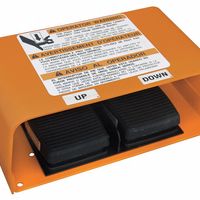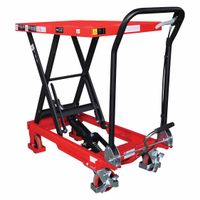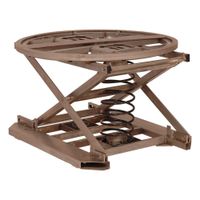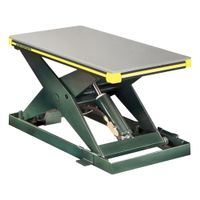Call +(254) 703 030 000 / 751 483 999 / 721 704 777
- Home
- Material Handling
- Lifting Pulling Positioning
- Lift Tables Turntables Pallet Positioners
.....Read More
Frequently Asked Questions
What are the benefits of using lift tables and pallet positioners for ergonomics?
Lift tables and pallet positioners significantly enhance workplace ergonomics by reducing physical strain and improving efficiency. These devices allow workers to adjust the height of their work surface, minimizing the need for bending, stretching, or twisting, which are common causes of musculoskeletal disorders. By maintaining a comfortable working posture, employees experience less fatigue and discomfort, leading to increased productivity and reduced absenteeism due to injury.
Lift tables facilitate the handling of heavy loads by elevating them to an optimal height, reducing the risk of back injuries. This is particularly beneficial in industries where manual lifting is frequent. Pallet positioners, on the other hand, automatically adjust the height of pallets as items are added or removed, ensuring that the top layer is always at a convenient height for workers. This constant adjustment minimizes repetitive strain and enhances workflow efficiency.
Both tools contribute to a safer work environment by reducing the likelihood of accidents associated with manual lifting and handling. They also promote better load distribution and stability, further minimizing the risk of workplace injuries. Additionally, these devices can be customized to suit specific tasks, providing flexibility and adaptability in various industrial settings.
Overall, the use of lift tables and pallet positioners not only improves worker safety and comfort but also enhances operational efficiency, leading to cost savings for businesses through reduced injury-related expenses and improved employee morale.
How do stationary lift tables differ from mobile lift tables?
Stationary lift tables and mobile lift tables are both designed to lift and position heavy loads, but they differ primarily in their mobility and application.
Stationary lift tables are fixed in one location and are typically bolted to the floor. They are used in environments where lifting tasks are repetitive and occur in a specific area, such as assembly lines, warehouses, or manufacturing plants. These tables are often powered by hydraulic, pneumatic, or electric systems and can handle heavier loads compared to mobile lift tables. Stationary lift tables are ideal for applications requiring stability and precision, as they provide a solid and secure platform for lifting. They can be customized with various platform sizes, lifting capacities, and additional features like tilt functions or rotating tops to suit specific tasks.
Mobile lift tables, on the other hand, are designed for flexibility and portability. They are equipped with wheels or casters, allowing them to be easily moved around a facility. This mobility makes them suitable for environments where lifting tasks are not confined to a single location, such as in maintenance, repair, or distribution centers. Mobile lift tables are generally lighter and have lower lifting capacities compared to stationary ones. They are often manually operated, though some models may have battery-powered lifting mechanisms. Mobile lift tables are ideal for tasks that require frequent relocation or when the lifting needs are temporary or variable.
In summary, the key difference lies in their mobility: stationary lift tables are fixed and suited for permanent, high-capacity lifting tasks, while mobile lift tables offer flexibility and are ideal for dynamic environments with varying lifting needs.
What are the key features to consider when choosing a lift table?
When choosing a lift table, consider the following key features:
1. **Load Capacity**: Ensure the lift table can handle the maximum weight of the items you intend to lift. Overloading can lead to equipment failure and safety hazards.
2. **Lift Height**: Determine the required lift height to ensure the table can reach the necessary elevation for your tasks.
3. **Platform Size**: Choose a platform size that accommodates the dimensions of the items being lifted, providing stability and safety.
4. **Power Source**: Decide between manual, electric, hydraulic, or pneumatic power sources based on your operational needs and available infrastructure.
5. **Mobility**: Consider whether a stationary or mobile lift table is more suitable for your workspace. Mobile tables offer flexibility, while stationary ones provide stability.
6. **Control Mechanism**: Evaluate the ease of use and precision of the control mechanism, whether it’s a foot pedal, hand crank, or push-button control.
7. **Safety Features**: Look for safety features such as overload protection, safety locks, and emergency stop buttons to prevent accidents.
8. **Durability and Build Quality**: Assess the materials and construction quality to ensure longevity and reliability under regular use.
9. **Adjustability**: Check for adjustable features like tilting or rotating platforms to enhance versatility for different tasks.
10. **Maintenance Requirements**: Consider the ease of maintenance and availability of replacement parts to minimize downtime.
11. **Compliance and Standards**: Ensure the lift table meets industry standards and regulations for safety and performance.
12. **Cost and Warranty**: Balance the cost with the features offered and check for a comprehensive warranty to protect your investment.
13. **Brand Reputation**: Research the manufacturer’s reputation for quality and customer service to ensure reliable support.
By considering these features, you can select a lift table that meets your operational needs efficiently and safely.
How do turntables and pallet carousels improve workflow efficiency?
Turntables and pallet carousels enhance workflow efficiency by optimizing material handling processes, reducing manual labor, and minimizing time spent on moving goods. These devices facilitate the smooth rotation and positioning of pallets, allowing workers to access items from all sides without the need for repositioning or excessive movement. This reduces the physical strain on employees, leading to fewer workplace injuries and increased productivity.
By enabling easy access to goods, turntables and pallet carousels streamline loading and unloading operations, significantly cutting down the time required for these tasks. This efficiency is particularly beneficial in high-volume environments such as warehouses, distribution centers, and manufacturing facilities, where speed and accuracy are crucial.
Moreover, these systems can be integrated with automated processes, further enhancing efficiency. Automated turntables and carousels can be programmed to rotate and position pallets precisely, reducing the need for manual intervention and allowing for seamless integration with conveyor systems and robotic arms. This automation leads to faster processing times and consistent workflow, reducing bottlenecks and improving overall throughput.
Additionally, turntables and pallet carousels contribute to better space utilization. By allowing for the compact storage and easy retrieval of goods, they maximize available floor space, enabling facilities to handle more inventory without expanding their physical footprint. This efficient use of space can lead to cost savings and increased operational capacity.
In summary, turntables and pallet carousels improve workflow efficiency by enhancing material handling speed, reducing manual labor, minimizing physical strain, integrating with automated systems, and optimizing space utilization, all of which contribute to a more streamlined and productive operation.
What maintenance is required for lift tables and pallet positioners?
Maintenance for lift tables and pallet positioners involves several key tasks to ensure their safe and efficient operation:
1. **Regular Inspections**: Conduct routine visual inspections to check for any signs of wear, damage, or misalignment. Look for leaks in hydraulic systems, frayed cables, and worn-out bearings.
2. **Lubrication**: Regularly lubricate moving parts such as hinges, rollers, and bearings to reduce friction and prevent wear. Use the manufacturer-recommended lubricants.
3. **Hydraulic System Maintenance**: Check hydraulic fluid levels and top up if necessary. Inspect hoses and connections for leaks or damage. Replace hydraulic fluid periodically as per the manufacturer's guidelines to prevent contamination and ensure optimal performance.
4. **Safety Features Check**: Test safety features like emergency stop buttons, limit switches, and safety skirts to ensure they are functioning correctly. Replace or repair any faulty components immediately.
5. **Load Testing**: Periodically perform load tests to ensure the equipment can handle its rated capacity. This helps in identifying any potential issues with the lifting mechanism.
6. **Cleaning**: Keep the equipment clean from dust, debris, and other contaminants that can affect its operation. Regular cleaning helps in maintaining the efficiency and longevity of the equipment.
7. **Alignment and Calibration**: Ensure that the lift table or pallet positioner is properly aligned and calibrated. Misalignment can lead to uneven wear and potential safety hazards.
8. **Electrical System Check**: Inspect electrical components for signs of wear or damage. Ensure that all wiring is intact and connections are secure.
9. **Documentation and Record Keeping**: Maintain detailed records of all maintenance activities, inspections, and repairs. This helps in tracking the equipment's condition and planning future maintenance.
10. **Training**: Ensure that operators are trained in the proper use and basic maintenance of the equipment to prevent misuse and identify potential issues early.
How do you determine the right lift table capacity for a specific application?
To determine the right lift table capacity for a specific application, consider the following factors:
1. **Load Weight**: Calculate the maximum weight the lift table will need to support, including the weight of the load and any additional equipment or tools placed on the table.
2. **Load Dimensions**: Assess the size of the load to ensure the lift table can accommodate it without compromising stability or safety.
3. **Lift Height**: Determine the required lift height to ensure the table can reach the necessary elevation for the application.
4. **Duty Cycle**: Evaluate how frequently the lift table will be used. A higher duty cycle may require a more robust lift table with a higher capacity to withstand frequent use.
5. **Type of Load**: Consider whether the load is static or dynamic. Dynamic loads, which involve movement or shifting, may require a higher capacity to account for additional forces.
6. **Safety Margin**: Incorporate a safety margin, typically 20-30% above the maximum load weight, to account for unexpected weight variations and ensure safe operation.
7. **Environment**: Consider environmental factors such as temperature, humidity, and exposure to chemicals, which may affect the lift table's performance and capacity.
8. **Regulatory Requirements**: Ensure compliance with industry standards and regulations, which may dictate specific capacity requirements.
9. **Manufacturer Specifications**: Consult the lift table manufacturer’s specifications and guidelines to ensure the selected model meets the application’s needs.
10. **Future Needs**: Anticipate potential future changes in load requirements to avoid the need for frequent upgrades.
By carefully evaluating these factors, you can select a lift table with the appropriate capacity to ensure efficient, safe, and reliable operation for your specific application.
What are common replacement parts for lift tables and pallet positioners?
Common replacement parts for lift tables and pallet positioners include:
1. **Hydraulic Cylinders**: Essential for the lifting mechanism, these may need replacement due to wear or leaks.
2. **Hydraulic Pumps**: Responsible for moving hydraulic fluid, pumps can fail or lose efficiency over time.
3. **Hydraulic Hoses and Fittings**: These components can develop leaks or cracks, necessitating replacement to maintain hydraulic pressure.
4. **Control Valves**: Used to direct hydraulic fluid, these can wear out or become clogged, affecting performance.
5. **Electric Motors**: In electric lift tables, motors can burn out or lose efficiency, requiring replacement.
6. **Power Units**: These include the motor, pump, and reservoir; a failure in any part may require replacing the entire unit.
7. **Scissor Legs and Pins**: The mechanical structure can suffer from metal fatigue or damage, needing replacement for safety.
8. **Platform Decks**: The surface can become damaged or worn, especially in high-use environments.
9. **Limit Switches**: These ensure the lift stops at the correct height and can fail or become misaligned.
10. **Bearings and Rollers**: Essential for smooth operation, these can wear out and need replacement.
11. **Safety Restraints and Locks**: These components ensure safe operation and may need replacement if damaged.
12. **Springs**: Used in some mechanical lift tables, springs can lose tension over time.
13. **Wheels and Casters**: For mobile units, these can wear out or become damaged.
14. **Electrical Components**: Wiring, connectors, and control panels can fail and require replacement.
15. **Seals and Gaskets**: These prevent leaks in hydraulic systems and can degrade over time.
Regular maintenance and inspection can help identify when these parts need replacement to ensure the safe and efficient operation of lift tables and pallet positioners.





